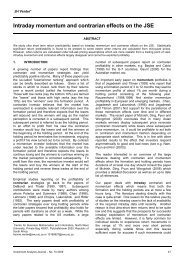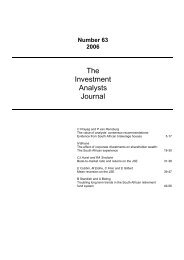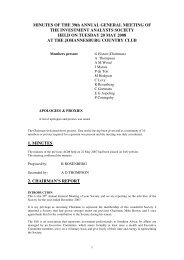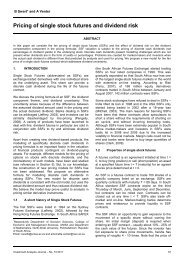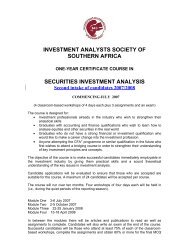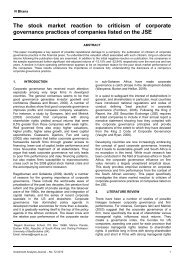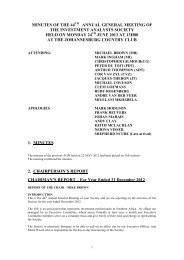Equity style timing - Investment Analysts Journal
Equity style timing - Investment Analysts Journal
Equity style timing - Investment Analysts Journal
Create successful ePaper yourself
Turn your PDF publications into a flip-book with our unique Google optimized e-Paper software.
<strong>Equity</strong> <strong>style</strong> <strong>timing</strong><br />
6.1 Value and growth: Small cap universe<br />
From Figure 1 above, five (including the start) turning<br />
points are evident from the relative performance graph.<br />
For the period from December 1986 to December<br />
1989, small cap value shares generally outperformed<br />
small cap growth shares. This trend was reversed until<br />
December 1992 when there was a cyclical shift into<br />
small cap value. This shift lasted until March 1994<br />
when growth came back into favour again. Growth<br />
continued to out perform value until November 1998<br />
when the cyclical shift again turned to value. From<br />
December 1998 to December 2002, however, value<br />
clearly outperformed growth, when the trend reversed<br />
before returning to favour value in August 2003.<br />
When examining only small cap shares, value and<br />
growth were profitable at different times over this<br />
period. Any investor able to consistently switch<br />
between the two, at the right time, would have outperformed<br />
an investor who bought and held small cap<br />
stocks.<br />
6.2 Value and growth: Large cap universe<br />
Figure 2 above shows the returns a <strong>style</strong> investor<br />
would have earned by investing only in large cap<br />
shares over the twenty-year period.<br />
Here the swings are less evident than in the small cap<br />
scenario, but no less dramatic. Starting in 1986, value<br />
was marginally ahead of growth, all the way to<br />
September 1991, when a definite shift out of value into<br />
growth occurred. This persisted until December 1992,<br />
when value came again to the fore. The next shift into<br />
growth started in November 1994 and persisted until<br />
December 1997 when a movement into value<br />
emerged, dominating until March 2001, when growth<br />
took over the trend to the current time.<br />
6.3 Proposition 2: There are persistent, and<br />
significant higher returns for <strong>style</strong><br />
managers following a high price to book<br />
ratio (growth) strategy as opposed to a low<br />
price to book (value) strategy<br />
If an investor were to ignore the influence of size and<br />
concentrate on the value/growth swings, the profile<br />
would have been that in Figure 3.<br />
The two time series seem to track each other closely,<br />
however the relative return series tells a different story.<br />
For the period between December 1986 and August<br />
1991, value marginally outperformed growth. From<br />
August 1991, growth clearly out-performed value until<br />
a turning point in December 1992, which shifted<br />
sentiment back to value. This trend prevailed until<br />
December 1994 when growth again came into the fore.<br />
Growth predominated until 1997 and since then value<br />
appears to have returned to favour, peaking in<br />
September 2001, and January 2003. Subsequently, it<br />
appears that returns to growth marginally outpaced<br />
returns to value for the period to 2006<br />
6.4 Proposition 3: A strategy of <strong>timing</strong> the <strong>style</strong><br />
turning points will out perform one of<br />
buying and holding the index.<br />
The following scenarios were modelled in order to<br />
investigate the efficacy of various levels of predictive<br />
accuracy in switching between <strong>style</strong>s. In all of these<br />
scenarios, the switching frequency used was monthly,<br />
i.e., all decisions to switch were made at the beginning<br />
of each month.<br />
• Perfectly accurate<br />
The investor was able to correctly predict every<br />
time a shift from value to growth happened, and<br />
was able to shift funds into the right <strong>style</strong>. In order<br />
to test this it was assumed that each time a shift<br />
happened, the investor was able to get into the<br />
outperforming <strong>style</strong> on time, and out of the underperforming<br />
<strong>style</strong> simultaneously.<br />
• Highly accurate<br />
In this scenario the investor was able to predict<br />
only the major switches discussed above and was<br />
able to move into the outperforming <strong>style</strong> and out<br />
of the under-performing <strong>style</strong>.<br />
• Perfectly inaccurate<br />
The investor made the wrong switch each month.<br />
Figure 4 shows that an investor who was able to<br />
perfectly time the market would have obtained a return<br />
of 43% pa. One who was able to find only the five<br />
major turning points would still have realised a return<br />
of 26,3% pa. An unfortunate investor who switched<br />
incorrectly each time would have lost 5,2%pa. In<br />
contrast, an investor who opted to invest in the<br />
Industrial or All Share Index would have obtained a<br />
return of 13,5% pa and 12,8% pa respectively.<br />
Clearly, any model designed to time the turns would<br />
have value, but only if it out performed the benchmark<br />
index as shown in Table 1 below:<br />
6.5 A prediction model<br />
To test the practical viability of a market <strong>timing</strong> strategy<br />
for different <strong>style</strong>s, a prediction model is required.<br />
The prediction model should (parsimoniously) indicate<br />
appropriate switching points between <strong>style</strong>s over the<br />
19 year period.<br />
20 <strong>Investment</strong> <strong>Analysts</strong> <strong>Journal</strong> – No. 65 2007




